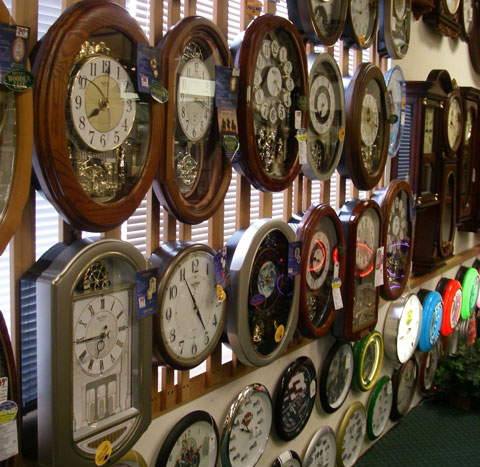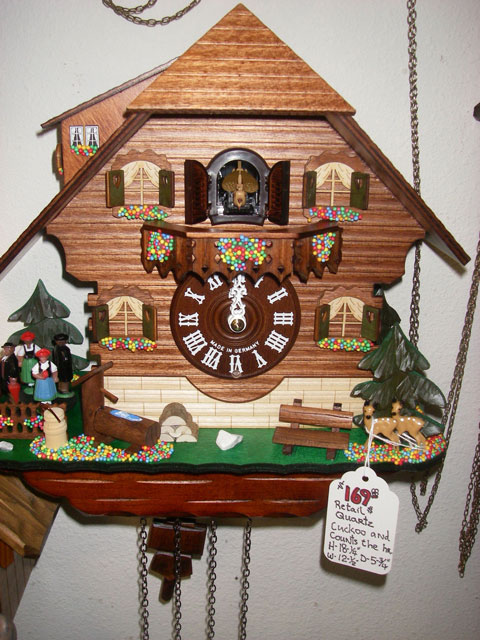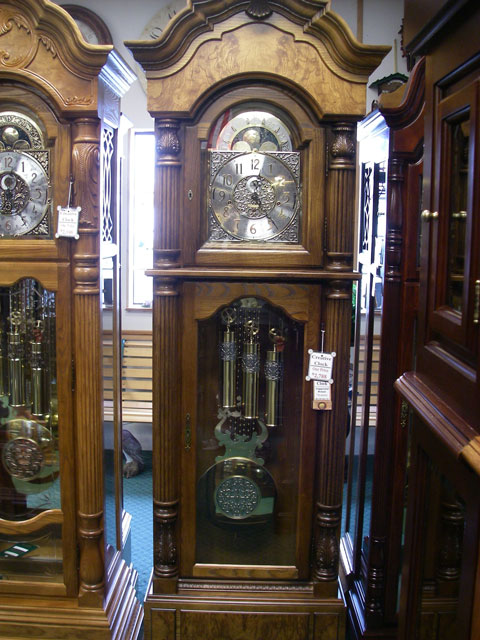Time-telling time capsuleJ.D. Olson displays his vast collection of clocks at West Eugene's Conger Street Clock Museum. More of J.D. Olson's clock collectionBy Mike O'BrienAt 3 p.m., the grandfather clock’s chimes echo in the air like church bells. A few minutes later, a cuckoo bursts out its door and starts chirping. Before the wooden bird finishes letting everyone in its vicinity know that an hour has passed, four figures emerge, singing “Jambalaya,” as they do every hour. J.D. Olson always knows what time it is because he wears a watch, but not because he owns the Conger Street Clock Museum in West Eugene. At CSCM, there are 1,000 clocks, no two of which are set for the same time, which mirrors Olson’s assertion that no two clocks are the same. “It could be the mechanics of it, the design of a case, a combination of things,” he said. “It’s like saying what makes a person unique.” But at the same time, Olson likes that clocks, no matter how different, have an inherent similarity. Clocks are very mechanic and follow certain laws: gravity, leverage or the law of the pendulum,” he said. A clockmaker by trade, Olson has always been fascinated by clocks, teaching himself to take apart an alarm clock as a kid in Millersville, Tenn., a small town 17 miles north of Nashville. About 12 years ago, his shop, Creative Clock, expanded to include Olson’s vast time-telling time capsule. “I’ve always had the collection,” he said. “As I gradually started bringing them in, eventually the museum just kind of took form.” The oldest piece in Conger Street Clock Museum, the back half of Creative Clock’s space, is a metal hand-tooled Clepsydra water clock from England, dates back to 1551. When the sun reached high noon, the clockmaker would fill a weighted canister with water until the clock’s hand pointed toward the sun. The drip rate was such that by the next day at noon, the hand would once again point skyward.  "Such a wonderful collection"“(Olson) has such a wonderful collection,” said Carolyn King of Monroe, just west of Junction City. “They get different clocks all the time and I get to look at them. This is a wonderful place, I buy a lot of stuff here.” Like Olson, King is fascinated by clocks. “How anyone could do something so intricate; it’s really neat,” she marveled. The museum also includes a century-old master school clock that rang bells in classrooms to signal lunchtime and recess; timers tied to the legs of carrier pigeons in the 1800s; a refrigerator-shaped clock General Electric used as a promotion in 1935; a clock tower built into a wall; a Davies Illuminated alarm clock from 1858, which would spring a match across sandpaper when the alarm triggered; and the little gold Schatz lantern clock from Germany that started Olson’s collection in 1962. “It didn’t work,” he said. “When I fixed it, it was just kind of a rewarding sensation.” Olson tends to all his clocks equally. Each is meticulously polished with silicone- and alcohol-free Whatiuse Orange Oil, giving the museum a faint citrus smell. Olson said most visitors are enamored by the Congreve rolling ball clock, named for Sir William Congreve, who invented the timepiece in 1808. A tiny pinball rolls along a zigzag path across a tilted surface, taking 30 seconds to complete the course. By the end of the year, the ball has traveled 2,586 miles, roughly the distance from Eugene to Baton Rouge, La.  "A lady came in here yesterday and said she’d expect to see this in Paris, not Eugene, Oregon.”In general, Olson said people are impressed by the museum’s variety. “They’re surprised there’s something like this in Eugene. A lady came in here yesterday and said she’d expect to see this in Paris, not Eugene, Oregon,” he said. Don Pivoda of Creswell thinks CSCM is a perfect fit for Eugene, a city with a transient population of University of Oregon students. “If (students) have family visiting, it’s safe to say they’re not going back to Korea or someplace without a souvenir from this place,” he said. Pivoda has some souvenirs of his own from this place: a grandfather clock, a wall clock with dancers who emerge from the face at the top of every hour and his favorite, a cuckoo clock. A native Californian whose in-laws live in Phoenix, Pivoda always takes visitors to CSCM, as well. “I never brought nobody here who was unhappy to be here; they just marvel,” he said. “It’s a unique place; that’s all you can say about it.” King also makes regular trips to CSCM whenever her sister visits from California. She said her sister can’t leave the store empty-handed and sometimes buys items she has no room for, which make their way into King’s 40-clock collection. While the museum is primarily dedicated to clocks, Olson also displays some of his other lifelong collections, such as telephones, cameras, whiskey decanters and model cars, including the first one Olson ever made: a Model T he built as a second-grader 50 years ago. CSCM also houses an 1898 Gray Pay Station, one of the first pay telephones ever made. But the focus is still clocks of all kinds: mantel clocks; intricately carved cuckoo clocks from the Black Forest of Germany; pocket watches; tall, distinguished looking grandfather clocks; digital alarm clocks; shifty-eyed cats with swinging tails; and everything in between. Though Olson is surrounded by clocks all day, he can’t pick just one favorite. He is an equal-opportunity clock connoisseur and prefers anything that’s “high-quality or intriguing.” Or, he added, “Anything that works.” |
